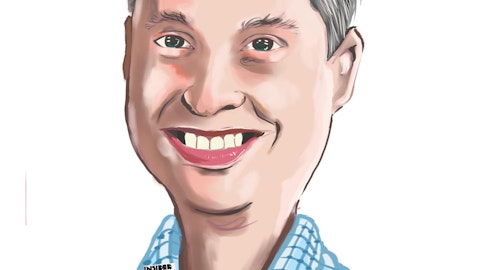But for now we leave it in the US. With respect to the group ratio, yes, there was some small movement in the group solvency ratio. Yes, we lose a little a bit of diversification benefits and there was some market movements, but I think your main question related back to the announcement that we had previously done with respect to the ASR transaction. So when we telegraphed the group solvency ratio, it did in fact include the loss of diversification benefits that we would get into the group. So that’s, I guess, the factual point. But as you had mentioned kind of in the last part of your question indeed, the group solvency ratio becomes even less important than it has been. We really look at the capitalization within the main country units together with cash capital at the holding is really the way that we manage capital within the group.
When I talked about the OCG bridge hopefully that was clear to you that we’ve upgraded our guidance for 2022 to €1.5 billion. But indeed we just — we have a lot of moving parts at this point and we want to work that through before giving any guidance on 2023. It goes no deeper than that.
Lard Friese: Yes. When it comes — Robin, just to finalize your list of questions. When it comes to regular buybacks and buyback potential for the company, I think, we’ve been quite clear about that last week. We — in the context of the combination that we’re going to create with ASR, the cash part of that consideration will come our way that we plan for a €1.5 billion return of capital. Of course we need to find a way to not make an endless, let’s say, timeframe. And we’ll navigate through that to make sure that we reduce the share count of the company with the €1.5 billion that we allocated for that. For the remainder, we have a stated policy which is that we have a cash buffer that we want to maintain between €0.5 billion and €1.5 billion, last week at the announcement of the ASR deal.
We also said that we want to maintain that at a higher level, because we want to do two things in the U.S. One is create profitable new growth and be able to fund that. And secondly, that we want to use also money for some additional management actions or in-force management actions that we may want to do in the U.S. to make sure that we are able to do that. But beyond that anything that is in excess, of what we need for the overall business plan et cetera has a very clear priority. And that is that number one it goes back to stockholders over time unless there is a value-creating opportunity in front of us but the main priority is I think clear from that. With that, I think we’ve gone through your list, so, back to the operator.
Robin van den Broek: Thanks.
Operator: Thank you for your question. We are now taking our next question. The question from Cor Kluis from AAOB. Please go ahead.
Cor Kluis: Good morning. It’s Two questions first of all, VA business, especially as a percentage point non-life capital in that system makes it more stable. I think you mentioned this positive probably on the long-term for the free cash flow. What’s the effect on the OCG or the capital generation of this transaction? And also related to this, are there more of such kind of transactions possible, because it’s a voluntary action.
Lard Friese: Yeah.
Cor Kluis: So is it possible that in a few quarters you will add again €300 million or something to make it even more stable? So that’s on the VA part. Then, other question is also partly related to the ASR transaction when you basically swapped the Aegon Netherlands for a stake in ASR. What effect does that have on the debt robust structure because of course — the holding and not in the unit? So the unit structure has changed as a result of this. Will that also — yes have some consequences for the holding debt structure? We know of course you’re going to reduce €700 million, but you also have to bring debt to other countries and whether they have impact on the interest cost other transactions? And maybe the last thing Matt that you just mentioned extra — you want to keep some extra capital in the U.S. for extra management actions. Could you elaborate on what kind of things we have to think about? That’s it from my side.
Lard Fries: Thank you very much Cor. The first three are going to be Matt and then the last one Duncan on the — transaction in the U.S, so, Matt, over to you for the first three.





